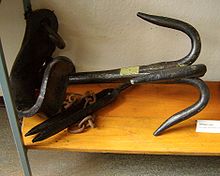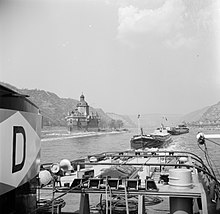Towing on the Rhine
This article deals with tugboat navigation on the Rhine with steam and diesel tugs .
history
The start of tug shipping on the Rhine was heralded with the first voyage of a steam-powered ship. On June 8, 1816, the London- built steamship Defiance , later renamed the Prince of Orange , sailed from Rotterdam to Cologne , where it arrived on June 12. Several trips with other ships followed, until on December 19, 1824 the side paddle steamer De Lek sailed from Rotterdam to Emmerich with a sailing ship in tow . The journey lasted 36 hours. On January 29, 1825, a second trip from Rotterdam to Cologne followed.
In 1827 the first German steamship on the Rhine was put into service. The Concordia had an English single-cylinder low-pressure steam engine with 70 hp and could carry 230 passengers and 1173 quintals of freight. Franz Haniel built the tug Ruhr I in 1845 , an iron ship with 400 hp. It pulled over 1000 tons in 4–6 barges. In the same year the Mathias Stinnes I also drove , equipped with a 200 HP two-cylinder composite steam engine .
Since the low-pressure engines were too prone to failure, consumed a lot of fuel and had little power due to the low pressure, the ships were converted to composite steam engines with higher pressure. These machines developed 800 hp and the travel time from Duisburg to Cologne was reduced from 40 to 19 hours, consumption was around 40% lower and the load on the trailer could be increased from 600 to 3000 tons of cargo.
The first screw tugs appeared around 1880, but they were not as powerful as the side wheel boats and they had a greater draft.
In the period from 1873 to 1905 the towers, so-called witches, sailed on the Lower and Middle Rhine. For this purpose, 43 mm thick wire ropes were laid in the Rhine, on which the witches pulled themselves up the stream using rope sheaves. See: rope
Tow train
The big paddle steamers pulled up to eight barges. On the ascent, the individual barges were packed according to their destination ports. To do this, the tug approached the barges to be towed and handed over the towing wire that was placed on the front double bollard on the barge . Then the boat sank until it had reached its towing position, so it went from boat to boat until the towing bandage was put together. The tugs were equipped with several large winches. Since each barge had its own towing wire , the barges ahead had to pick up the tow lines and hang them in the Brittel hook. On the tugboat, the wires were a Zeistau bundled and in the entourage stoppers fixed. Most of the time there was a smaller barge hanging on the first length, the so-called free rider . The last boat was tied to the towing wire of the penultimate boat with the Brittelstrang . Some of the tow trains were over a kilometer long. Now the tug was ready to go. After the ship's bell sounded three times, the captain said the traditional saying: In God's name - Good rice , and then the journey started. At the respective ports of destination, the barges threw their lines and tried to berth with their own swing. In locks , the barges were pulled in with winches or small locomotives and the crew had to stop the ship by hand in the lock.
Tug trains going to the Upper Rhine were divided in Bad Salzig , as only three attachments were allowed on the mountain route. At times there were several hundred barges in the roadstead. Behind Bingen , the tow trains were rearranged.
In the descent two barges were coupled side by side, loaded barges drove directly behind the tug, and only the first attachment had a towing wire from the tug. The distance to the tractor was also shorter than on the way up.
We only sailed from sunrise to sunset, shipping also stopped in fog, radar and radio did not yet exist in inland shipping. The work on the barges was very exhausting and full of privation. Electricity or other mechanical aids were not known. The steering wheel, initially lying in the open wheelhouse, was huge, up to 6 meters in diameter. Depending on the route, with a lot of current or during maneuvers, several men had to reach into the spokes. Even on the steam tugs that did not have a steam-powered steering gear, there were always several people at the helm.
The last towing trip with a side-wheel tug was in 1967. It was the tug Oscar Huber , now a museum ship in Duisburg.
Technical data of a wheeled tractor
- Length = 75 m, with bowsprit and rudder 80.0 m
- Width = 20.75 m above the wheel arches, trunk width = 9.0 m
- Draft loaded = 1.55 m
- Load capacity = 200 tons.
- Three-cylinder steam engine 1550 hp
- Two steam boilers
- The eccentric paddle wheels were up to 6 meters wide
- Towing power of up to 6000 tons, corresponds to 6–7 barges
- Consumption = Duisburg-Rotterdam and back around 70 tons of coal in six days
- Consumption after conversion to oil = Duisburg-Karlsruhe and back 60–70 tons in 16 days
- Crew = coal 15 men, oil 8 men. Captain, helmsman, helmsman, 2 machinists, 3 sailors, 4–6 stokers and a menage man who was responsible for the provisions and cooking.
- The largest barges had a load capacity of over 3000 tons and, depending on their size, a crew of up to four men.
Screw tractor
After a better efficiency was achieved through the further development of the ship propellers , one and two-screw tugs were built for long-distance travel. These were smaller and therefore cheaper than the wheeled tractors. In addition, the crew was smaller. A special feature was a second propeller, the pre-screw, on the propeller shaft. In 1882 the first twin screw boat was launched. Steam turbine-powered tugs were also built. From 1912 diesel engines were installed for the first time . The state had a monopoly on towing the canals .
Diesel tractor
After the First World War , many ships were converted to diesel engines; Haniel even had two diesel engines installed in a paddle steam tug. In the course of time, the steam tugs disappeared and were replaced by diesel tugs. These tugs were much more motorized and required less staff. In 1922 the shipping company Haniel from Duisburg had the twin screw tractor Haniel XXVIII built. This tug had two 6-cylinder MAN diesel engines with a total of 3000 HP and could tow 5500 tons. The most powerful tractor, the Unterwalden , had 4000 hp.
The end of tugboat shipping
At the turn of the 19th to the 20th century, pusher shipping was developed in the USA. In Germany in 1931 the first attempts were made with the UHU push boat on the Danube . On August 27, 1957, the converted French tug President Herrenschmidt drove with two converted barges from Rotterdam to Strasbourg, on November 3, 1957 the push boat Wasserbüffel drove with four barges of 1250 t each on the Lower Rhine route. The advantage of pusher shipping is the much lower manpower requirement and the simple design of the barges . Many former barges were motorized or scrapped when it was no longer worth renovating due to their age. Tugs were also partially converted into passenger ships.
Identification of a towing formation
During the day, the towing ship must carry a yellow buoy that is visible all around, with a black and white ring at each end. The last ship of the association carries a yellow ball.
At night, the towing ship leads two masthead lanterns one above the other at a distance of one meter and at least one meter above the sidelights and a yellow stern lantern. The towed ships have a white lantern that is visible all around on the foredeck, at least five meters above the sink mark, and the last attachment also has a stern lantern.
If several motor ships are towing a towing convoy next to each other, the three outer masthead lanterns must be positioned one meter above the other. If several tugs are coupled next to each other, the outer ships must have a white all-round light.
Museums
- Museum of German Inland Shipping , Duisburg
- Probation and pilot museum, Sankt Goar
- Rhine Museum, Koblenz
- Rafting and shipping museum, Kamp-Bornhofen
See also
literature
- From steam to diesel, The Rhine-Schleppschifffahrt im Wandel, Werner Böcking, ISBN 3-89413-204-3
- Kurt Uhlenbruck: The tugboat ride on the mountain stretch of the Middle Rhine . A folklore study (Studies on Folklore 29). Diss. Mainz 2003, 285 p., Numerous ill.Review in: Contributions to Rheinkunde, Heft 55/56, 2003/2004, Koblenz 2004, p. 101
- Armin A. Hummel: '' Die Ruthof-Werft Mainz-Kastel and Regensburg, 1871 - 1975 '', Edition Winterwork Borsdorf 2018, ISBN 978-3-96014-456-4 , pp. 81–86.






